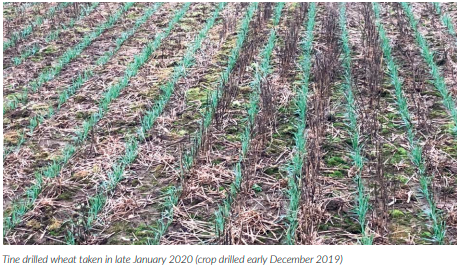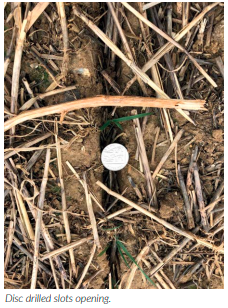Written by James Warne, Soil First Farming
Social media can be a useful source and tool for knowledge transfer, discussion around various topics etc. But far too often it can also be the source of misinformation or confirmation of prejudice, particularly where the discussion deviates from received wisdom. I am referring here to agriculturally based discussions around the topics of Conservation Agriculture (CA), soil nutrition, agronomy etc. There are some common recurring themes which need addressing because all too often much of the advice given is in my opinion flawed for many and various reasons. In this article I will touch on a few of these questions…
‘My soil is not ready’
‘My soil is not ready’ is a common retort. When will your soil be ready? Next year, in two years or five years? By what criteria are you assessing your soil to make this statement? To paraphrase Morrissey, my normal response to this question is how soon is now? The point being that while you continue to cultivate you are slowly, but surely, moving your soil further away from that point of ‘being ready’, whatever that is. Cultivation, while undoubtably bringing some short-term benefits, also brings about its own set of problems; reduced porosity over the longer term; oxidation of organic matter; decimation of worm populations; increased risk of run-off and soil erosion with the consequential issues of diffuse water pollution from fertiliser and pesticides, to name a few.
The path towards Conservation Agriculture can start now if you want it to. Every year of dither and delay is another harvest where you didn’t try something new, and maybe didn’t benefit from the potential to reduce establishment cost. One certainty is that agricultural production in the UK is sliding down the political agenda which will result in reducing financial support. What is apparent from the last few months is that food security is not on the current governments agenda unless it is by means of food import. Whichever way you look at it farming is going to have to work hard to cut its production costs to remain profitable.
So, back to the original question when will the soil be ready? The questions you need to ask yourself are; how did the field in question yield at the last harvest? If the answer is ‘as well as could be expected and comparable to other fields’ that’s a good starting point. Have you trafficked said field with harvest operations or post-harvest operations such as muck spreading or baling? And finally, have you taken a spade out and looked at the soil structure? If you are happy with all the above questions then now is a good time to start changing the system. If you at all uncertain then call in a third-party opinion.
This soil probably isn’t ready for no-till.
You can of course reduce the risk by not converting the whole farm in one year, consider implementing the system across a whole rotation or maybe two rotations. But do not fall into the trap of opportunistic direct drilling as a way of reducing establishment cost because you will never realise the full benefits of the system. Each subsequent cultivation effectively resets the clock and you end up having to travel through the troublesome early years of soil cultivation ‘cold turkey’ (see below) each time. You haven’t reduced the fixed cost structure of the business because you have been holding onto cultivation equipment that could be sold.
‘I have the wrong type of soil’, (it’s too heavy, too light or contains too much silt etc, etc)
Any soil type can be successfully managed through a CA system but it’s true some demand a lot more attention than perhaps others. Light sandy soils with very low organic matter will have a tendency to quickly slump and consolidate, this also applies to soils with a high silt content. Much care has to be applied to field operations only happening when the soil is able to carry the machinery.
Cover crops and cash crops with good rooting characteristics should be grown in the early years as this is what is going to give the soil structural and physical stability. I cannot stress this enough, it’s so important to avoid any performance drop which is one of the main obstacles to adoption. As far as plant growth is concerned the important factor is the pore space characteristics are strongly influenced by the stability of the soil structure when wetted. The presence of earthworms, plant exudates, humus and plant roots themselves all act to encourage the formations of soil structures stable in water.
Clay based soils will have a degree of natural structure provided by the clay colloid, whereas the silts and sands will not have much clay and little organic colloid to help with structure. These soils are often easier to manage in the earlier years, especially where they are calcareous and therefore will have a good calcium carbonate content. As alluded to above the key to success is the early introduction of large amounts of carbon either by chopping residues, spreading manures and compost etc, and by growing cover crops. Doing all of these in the early years is necessary to stabilise the soil structure, to encourage natural porosity and fertility.
‘I am looking at buying a disc drill’
Many seem to be obsessed with moving the minimal amount of soil and consequently are looking at disc drills because they are all over social media. Yes, this is true, disc drills can move very little soil and that can be a good function in some circumstances, but not always and certainly not at the beginning. In the early years the soil will be in a state of cultivation ‘cold turkey’. Take away the cycle of annual cultivation and the soil will start to slump, consolidate and loose porosity before the biology and chemistry starts to sort out the physical stability of the soil and increase the porosity once again. This can reduce crop performance in the early years, this is cultivation cold turkey. Tine drills by their very action will create a little tilth and give a better result more often than not especially when soils are dryer or wetter than ideal.

Tine drills can also drill through green cover if judiciously managed, and they will certainly drill through chopped straw better than any disc drill. The fallacy of only using a disc drill has been shown time and again over the winter months. Poorly established or failed wheat crops resulting from using disc drills on over-wet soil can be seen all over the country. Where tine drills have been used the results are considerably better, but still not perfect. Even this spring it is very easy to spot crops which have been disc drilled where the slots are opening as the soil dries revealing the plant roots to the air and increasing the rate of soil moisture loss. When I mention tine drills I am not referring to those with any form of leading leg, these are strip-till drills and should not be confused with a genuine no-till tine drill. Leading leg strip-till drill designs move too much soil to be ever considered for a genuine CA system.

Don’t believe everything you read on social media (unless it’s about government hypocrisy), get a second opinion, or visit someone who’s already doing it. No-till is part of the solution, not part of the problem.